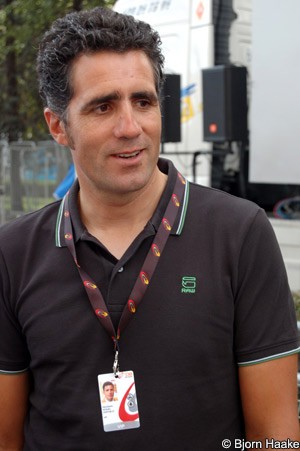Spaniard was honored for his second Tour de France win in 1992
 Miguel Indurain, five-time winner of the Tour de France, has visited the museum of evolutionary humanity in Burgos, Spain. Indurain’s purpose of the visit was to check out the Homo heidelbergensis that was named Miguelón (“Big Mig”) in honor of his Tour de France win in 1992.
Miguel Indurain, five-time winner of the Tour de France, has visited the museum of evolutionary humanity in Burgos, Spain. Indurain’s purpose of the visit was to check out the Homo heidelbergensis that was named Miguelón (“Big Mig”) in honor of his Tour de France win in 1992.
Indurain was invited by María José Salgueiro, Culture and Tourism councilor for the region of Castilla y León, according to esciclismo.com. Indurain was shown the remains that are perfectly reconstructed, according to Salgueiro.
Indurain was pleased to meet the other Miguelón. “We haven’t gotten to know each other yet,” a smiling Indurain said. “I knew it was traveling to the Shanghai Exhibition, and now finally it is here.” Indurain was impressed by the work of the team to reconstruct the skull. The skull was found in Atapuerca, which lies on the famous Camino de Santiago, a pilgrim’s path from the Pyrenees to Santiago de Compostela.
Indurain spent two hours in the museum, asking questions about fossils and human’s evolution. He was accompanied by his wife, with the race director of the Vuelta a Castilla y León also in attendance.
The general coordinator for the museum, Aurora Martín, recalled the idea for naming the heidelbergensis Miguelón. “The skull was discovered in July, when Indurain was about to win his second Tour de France. It is custom to name discoveries with familiar names, given that the scientific names are hard to remember. Juan Luis Arsuaga and his team came up with Miguelón and we all liked it.”
Indurain also visited the Galería de los Homínidos, where ten different species of human evolution are displayed. Salgueiro was quite pleased that Indurain stopped by for a visit.
Five Tour wins, a Worlds title, an Olympic title and the hour record
Indurain was the first rider to win five Tours de France consecutively, taking the victories from 1991 to 1995. His superior time trial skills allowed him to gain big advantages before the mountains, where he would hang on with the skinny climbers. But if necessary, Indurain also attacked on the hills. In 1994, he stormed up Hautacam, in pursuit of Marco Pantanti. Indurain, with Luc Leblanc in tow, caught and passed Pantani a couple of kilometers from the finish, allowing Leblanc to win the stage on home soil.
Indurain was well known for his descending skills, badly needed in the 1993 Tour de France. Indurain was sick on stage 17 and trailed Tony Rominger by almost a minute on the Tourmalet. It took the Spaniard some ten kilometers of descending to catch back up.
In 1992 and 1993 he won the Tour and the Giro d’Italia in the same year. He also took overall wins in Paris-Nice (1989, 1990), the Critérium du Dauphiné Libéré (1995, 1996), the Vuelta a Castilla y León (1993), the Critérium International (1989), the Vuelta a Catalunya (1988, 1991, 1992), the Vuelta a Murcia (1986), along with the one-day race Clasica San Sebastian in 1990.
He beat the hour record in 1994 (53,040 kilometer in Bordeaux, France) and became time trial World Champion in Bogotá, Colombia, in 1995. He was also the Olympic time trial champion in 1996 (Atlanta). The only race that he chased in vain was the road World Championships title. In 1993 he was beaten by a then-unknown Lance Armstrong, settling for the silver medal. In 1995 he looked the strongest but showed his loyalty to teammate Abraham Olano. Olano attacked and Indurain blocked any chasing efforts by Marco Pantani to let his compatriot win gold.
It was Indurain’s second silver and last shot at the Worlds title. In 1996, he was beaten in his last Tour de France, finishing 11th. His sports director made him ride the 1996 Vuelta, which he abandoned. He then announced his retirement on January 1, 1997.